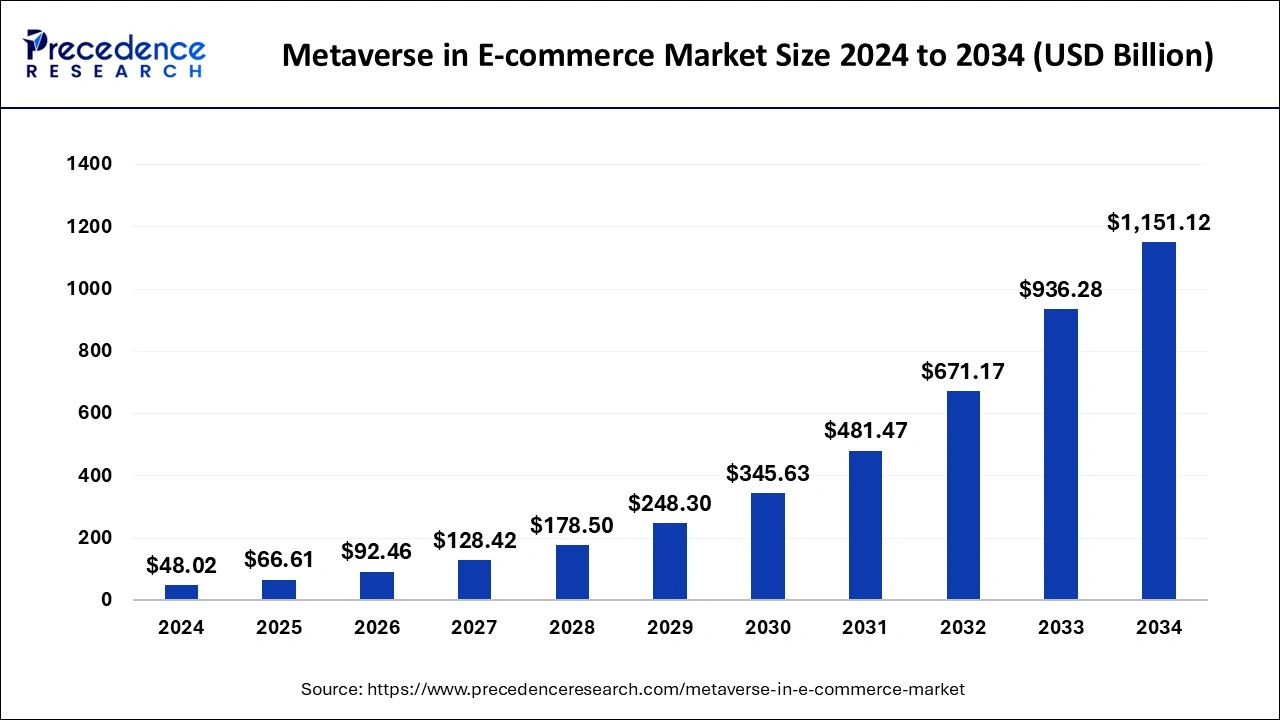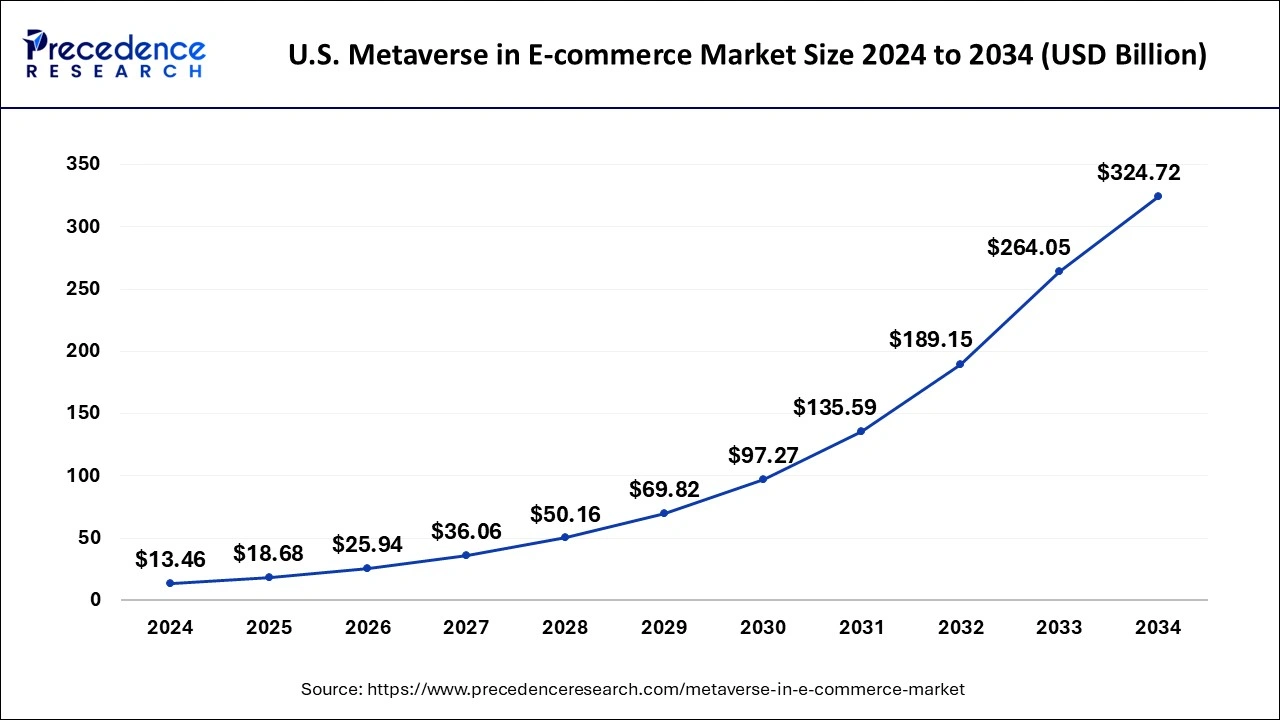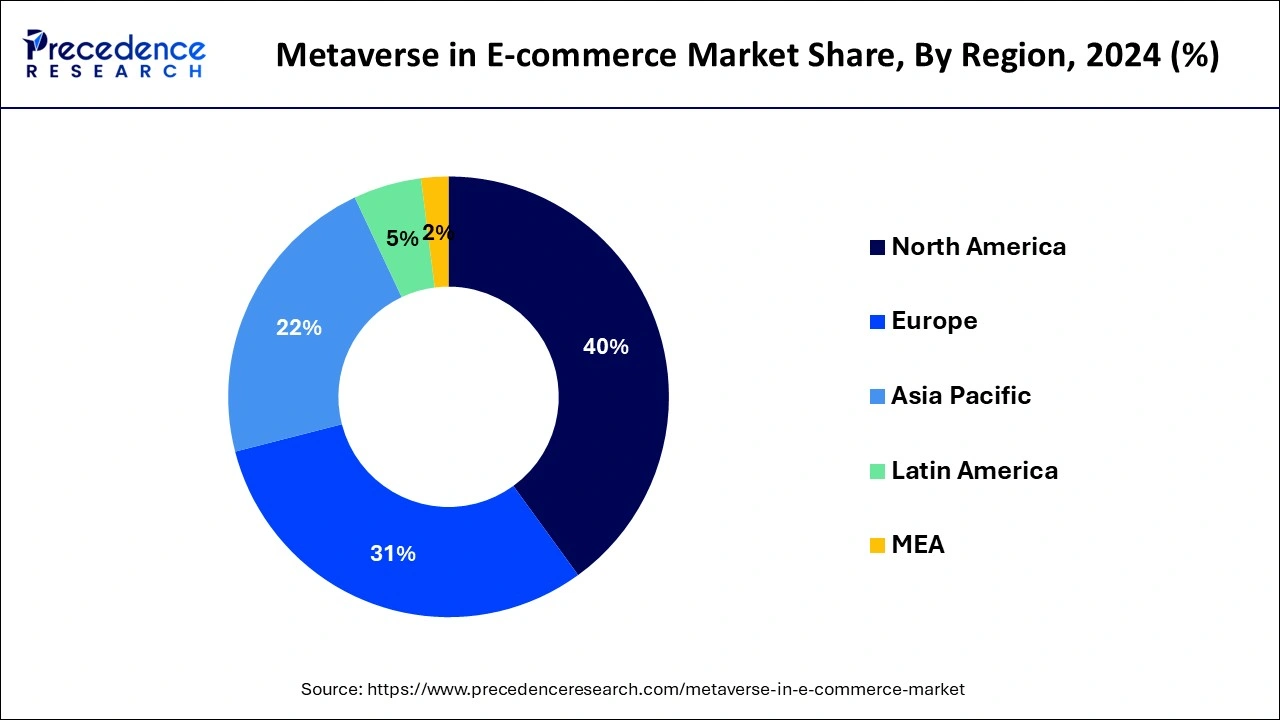Metaverse in E-commerce Market Size and Forecast 2025 to 2034
The global metaverse in e-commerce market size accounted for USD 48.02 billion in 2024 and is predicted to increase from USD 66.61 billion in 2025 to approximately USD 1,151.12 billion by 2034, expanding at a CAGR of 37.39% from 2025 to 2034.

Metaverse in E-commerce MarketKey Takeaways
- The global metaverse in e-commerce market was valued at USD 48.02 billion in 2024.
- It is projected to reach USD 1,151.12 billion by 2034.
- The metaverse in e-commerce market is expected to grow at a CAGR of 37.39% from 2025 to 2034.
- North America contributed more than 40% of market share in 2024.
- Asia-Pacific is estimated to expand the fastest CAGR between 2025 and 2034.
- By platform, the computer segment has held the largest market share of 36% in 2024.
- By platform, the headset segment is anticipated to grow at a remarkable CAGR of 40.12% between 2025 and 2034.
- By technology, the AR and VR segment generated over 37% market share in 2024.
- By technology, the mixed reality segment is expected to expand at the fastest CAGR over the projected period.
U.S.Metaverse in E-commerce Market Size and Growth 2025 to 2034
The U.S. metaverse in e-commerce market size was exhibited at USD13.46 billion in 2024 and is projected to be worth around USD 324.72 billion by 2034, growing at a CAGR of 37.48% from 2025 to 2034.

North America holds a share of 40% in the metaverse in e-commerce market due to advanced technological infrastructure, widespread internet accessibility, and a tech-savvy population. Major tech companies, headquartered in this region, drive innovation and investment in metaverse technologies. Additionally, a strong e-commerce ecosystem, coupled with high consumer spending, fuels the growth of virtual shopping experiences. The early adoption of metaverse trends by North American businesses and consumers positions the region at the forefront, contributing to its substantial share in the evolving metaverse e-commerce market.

The metaverse in the Asia-Pacific e-commerce market is set for rapid growthdue to increased digital adoption, rising internet connectivity, and a tech-savvy population. The region's flourishing online consumer base is driving demand for immersive and interactive shopping experiences. Additionally, the tech infrastructure investments and initiatives by various Asian countries contribute to the metaverse's expansion. With a combination of growing digital ecosystems, favorable demographics, and forward-looking policies, the Asia-Pacific region presents a fertile ground for the metaverse to thrive and reshape the future of e-commerce.
Meanwhile, Europe is experiencing substantial growth in the metaverse for e-commerce due to increased technological adoption, improved internet infrastructure, and a rising trend of online engagement. The region's consumers are embracing immersive online experiences, creating a demand for metaverse-based shopping. Businesses are leveraging this momentum by establishing virtual storefronts, providing unique and interactive shopping environments. Additionally, the metaverse's integration with social commerce aligns with European consumers' preferences for personalized and socially-driven shopping experiences, contributing to the remarkable expansion of the metaverse in the European e-commerce market.
Market Overview
The metaverse in e-commerce refers to a virtual, interconnected space where users can engage in immersive online experiences, combining aspects of social interaction, gaming, and commerce. In this digital realm, users can explore virtual stores, interact with products, and make purchases through interactive interfaces. Imagine a 3D online shopping environment where customers create personalized avatars, socialize with others, and seamlessly browse and buy products. E-commerce businesses are increasingly exploring the metaverse to enhance customer engagement, replicate real-world shopping experiences, and provide a more dynamic and interactive platform for online transactions. The metaverse in e-commerce holds the potential to revolutionize how people shop, bringing a new dimension to the online retail landscape.
Metaverse in E-commerce Market Growth Factors
- The metaverse enhances e-commerce by providing immersive and interactive shopping environments. Users can virtually explore products, try them out, and engage in a more dynamic shopping experience, bridging the gap between physical and online retail.
- Metaverse platforms often include social features, allowing users to connect, share experiences, and make purchase decisions collaboratively. This social commerce aspect leverages virtual communities, fostering a sense of community and shared interest among consumers.
- Blockchain technology, commonly integrated into metaverse platforms, enables decentralized ownership of virtual assets. This provides a secure and transparent way for users to buy, sell, and trade virtual goods, creating new opportunities for e-commerce transactions within the metaverse.
- Companies can establish a virtual presence within the metaverse, akin to setting up a digital storefront. Acquiring virtual real estate allows brands to showcase products, host events, and create unique, branded experiences, expanding their reach and engaging with consumers in novel ways.
- Non-fungible tokens (NFTs) play a significant role in the metaverse, enabling the creation of unique digital assets. E-commerce in the metaverse can involve the sale of NFT-backed digital products, limited editions, and virtual collectibles, creating new revenue streams for businesses.
- Metaverse platforms often support interoperability, allowing users to seamlessly transition between different virtual worlds and platforms. This interconnectedness facilitates a more fluid e-commerce experience, enabling users to carry their virtual possessions and preferences across various metaverse environments, leading to a more integrated and user-centric shopping journey.
Market Scope
| Report Coverage | Details |
| Growth Rate from 2025 to 2034 | CAGR of 37.39% |
| Global Market Size in 2025 | USD 66.61 Billion |
| Global Market Size by 2034 | USD 1,151.12 Billion |
| Base Year | 2024 |
| Forecast Period | 2025 to 2034 |
| Segments Covered | Platform and Technology |
| Regions Covered | North America, Europe, Asia-Pacific, Latin America, and Middle East & Africa |
Market Dynamics
Driver
Rise of virtual assets
- In 2022, virtual land transactions in metaverse platforms like Decentraland and Sandbox reached a total value of $50 million, showcasing a growing market for digital real estate.
The growing popularity of the metaverse in e-commerce is closely linked to the boom in virtual assets. As more people dive into virtual worlds, the idea of owning digital stuff using blockchain, like virtual land or special digital items represented by NFTs, has become popular. This ownership aspect adds extra value and uniqueness to virtual goods, sparking a big demand in the market. People are not just interested in the metaverse for the fun experience; they also want to own special digital things. Virtual assets provide a feeling of having something exclusive, creating a new and valuable market within the metaverse. This surge in the desire for virtual assets is boosting e-commerce in the metaverse, with users actively buying, selling, and trading within these digital spaces.
Restraint
Cost of entry
The cost of entry stands as a significant restraint in the metaverse's impact on the e-commerce market. Creating a presence in the virtual realm demands substantial financial investment, deterring smaller businesses from participating. The expenses include not only developing and maintaining a virtual storefront but also crafting immersive experiences that engage users. This financial barrier can limit the diversity of businesses entering the metaverse, potentially slowing down its widespread adoption.
For many small enterprises, the cost of embracing metaverse technology is a substantial hurdle. This restrains market demand as it prevents a broad spectrum of businesses from venturing into the metaverse for e-commerce. As the technology matures and becomes more accessible, addressing these cost concerns will be essential in unlocking the full potential of the metaverse for a diverse range of businesses, ensuring a more inclusive and robust e-commerce landscape within virtual spaces.
Opportunity
Social commerce impact
- A survey revealed that 70% of users in virtual worlds consider recommendations from their virtual friends while making purchase decisions, demonstrating the impact of social commerce within the metaverse.
The impact of social commerce is creating significant opportunities in the metaverse for the e-commerce market. By integrating social features within virtual environments, users can share experiences, product recommendations, and purchase decisions in real-time. This social interaction enhances the overall shopping experience, mimicking the social aspects of traditional brick-and-mortar stores. As a result, businesses in the metaverse have the chance to leverage user-generated content and word-of-mouth marketing, fostering a sense of community that drives engagement and sales.
The metaverse's social commerce potential is particularly beneficial for brands seeking authentic connections with their audience. Virtual spaces provide a platform for interactive and collaborative shopping, where users can explore products together and receive real-time feedback. This dynamic interaction not only enhances customer engagement but also opens up new avenues for businesses to build brand loyalty and capitalize on the social influence of users within the metaverse, creating exciting opportunities for growth in the e-commerce market.
Platform Insights
The computer segment held the highest market share at 36% in 2024. In the metaverse's computer segment for e-commerce, this refers to the digital spaces accessed via personal computers. Users can explore virtual stores, interact with products, and make purchases through their computers. A key trend involves improved graphics and processing power, enabling more immersive and realistic experiences. As e-commerce platforms optimize for computer access, the metaverse on PCs is witnessing a trend towards enhanced visuals and user interfaces, making virtual shopping more seamless and engaging for users accessing the metaverse through their computers.
The headset segment is anticipated to witness rapid growth at a significant CAGR of 40.12% during the projected period. In the metaverse e-commerce market, the headset segment refers to virtual reality (VR) and augmented reality (AR) devices that users wear to access immersive virtual experiences. These headsets enable consumers to engage with the metaverse, including shopping in virtual stores, trying out products, and attending virtual events. Recent trends indicate a surge in demand for more user-friendly and affordable headsets, driving innovation in the development of devices that offer enhanced comfort, improved graphics, and seamless integration, contributing to the growth of metaverse-based E-commerce.
Technology Insights
The AR and VR segment has held a 37% market share in 2024. In the metaverse's e-commerce market, augmented reality and virtual reality play pivotal roles. AR enhances the user's real-world environment with digital overlays, allowing them to visualize products in their own spaces before purchase. VR, on the other hand, immerses users in entirely virtual environments for a more interactive shopping experience. The trend shows a growing integration of AR for virtual try-ons and product visualization, while VR is increasingly used for creating immersive virtual stores, transforming how users explore and engage with products in the metaverse.
The mixed reality segment is anticipated to witness rapid growth over the projected period. In the metaverse's e-commerce market, the mixed reality segment blends elements of augmented and virtual reality. It integrates physical and digital worlds, allowing users to interact with virtual objects in their real environment. This technology trend enables immersive shopping experiences where customers can virtually try products before purchasing, enhancing the online shopping journey. The mixed reality segment is evolving rapidly, with ongoing innovations aiming to bridge the gap between the virtual and physical realms, offering exciting possibilities for a more interactive and engaging metaverse e-commerce experience.
Recent Developments
- In February 2022, Sony launched the VR2 and VR2 Sense Controllers for PlayStation 5, offering users an immersive virtual reality (VR) experience. These advancements aim to provide a heightened gaming experience with improved visual clarity and enhanced tracking capabilities.
- Additionally, Virtex, in July 2021, announced plans to unveil "Virtex Stadium," a virtual reality venue that allows fans to enjoy games together from a central field perspective. This innovation aligns with the growing popularity of e-sports and the continual enhancement of consumer VR hardware. According to data from VentureBeat, the global eSports audience, which stood at 474 million in 2021, is projected to reach 577.2 million by 2024, indicating a rising trend in virtual sports engagement.
Metaverse in E-commerce Market Companies
- Facebook (Meta)
- Amazon
- Microsoft
- NVIDIA
- Unity Technologies
- Epic Games
- Decentraland
- Roblox Corporation
- Shopify
- Alibaba Group
- Tencent Holdings
- Magic Leap
- HTC Corporation
- Samsung Electronics
Segments Covered in the Report
By Platform
- Computer
- Mobile
- Headset
By Technology
- AR and VR
- Blockchain
- Mixed reality
- Others
By Geography
- North America
- Europe
- Asia-Pacific
- Latin America
- Middle East and Africa
For inquiries regarding discounts, bulk purchases, or customization requests, please contact us at sales@precedenceresearch.com
Frequently Asked Questions
Ask For Sample
No cookie-cutter, only authentic analysis – take the 1st step to become a Precedence Research client
 sales@precedenceresearch.com
sales@precedenceresearch.com
 +1 804-441-9344
+1 804-441-9344